
A solid-propellant rocket or solid rocket is a rocket with a rocket engine that uses solid propellants (fuel/oxidizer). The earliest rockets were solid-fuel rockets powered by gunpowder; they were used in warfare by the Chinese, Indians, Mongols and Persians as early as the 13th century.

Titan was a family of United States expendable rockets used between 1959 and 2005. The Titan I and Titan II were part of the US Air Force's intercontinental ballistic missile (ICBM) fleet until 1987. The space launch vehicle versions contributed the majority of the 368 Titan launches, including all the Project Gemini crewed flights of the mid-1960s. Titan vehicles were also used to lift US military payloads as well as civilian agency reconnaissance satellites and to send interplanetary scientific probes throughout the Solar System.

Delta II was an expendable launch system, originally designed and built by McDonnell Douglas, and sometimes known as the Thorad Delta 1. Delta II was part of the Delta rocket family and entered service in 1989. Delta II vehicles included the Delta 6000, and the two later Delta 7000 variants. The rocket flew its final mission ICESat-2 on 15 September 2018, earning the launch vehicle a streak of 100 successful missions in a row, with the last failure being GPS IIR-1 in 1997.

The Delta rocket family is a versatile range of American rocket-powered expendable launch systems that has provided space launch capability in the United States since 1960. Japan also launched license-built derivatives from 1975 to 1992. More than 300 Delta rockets have been launched with a 95% success rate. The series has been phased-out in favor of the Vulcan Centaur, with only the Delta IV Heavy rocket remaining in use as of June 2023.

BYEMAN codenamed GAMBIT, the KH-7 was a reconnaissance satellite used by the United States from July 1963 to June 1967. Like the older CORONA system, it acquired imagery intelligence by taking photographs and returning the undeveloped film to earth. It achieved a typical ground-resolution of 0.61 m to 0.91 m. Though most of the imagery from the KH-7 satellites was declassified in 2002, details of the satellite program remained classified until 2011.
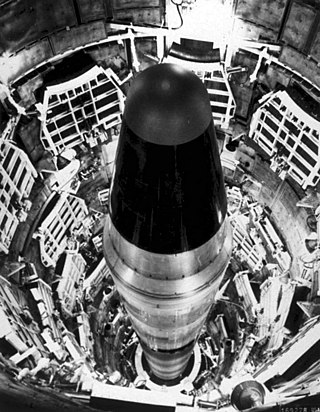
The Titan II was an intercontinental ballistic missile (ICBM) developed by the Glenn L. Martin Company from the earlier Titan I missile. Titan II was originally designed and used as an ICBM, but was later adapted as a medium-lift space launch vehicle to carry payloads to Earth orbit for the United States Air Force (USAF), National Aeronautics and Space Administration (NASA) and National Oceanic and Atmospheric Administration (NOAA). Those payloads included the USAF Defense Meteorological Satellite Program (DMSP), NOAA weather satellites, and NASA's Gemini crewed space capsules. The modified Titan II SLVs were launched from Vandenberg Air Force Base, California, up until 2003.

Titan IV was a family of heavy-lift space launch vehicles developed by Martin Marietta and operated by the United States Air Force from 1989 to 2005. Launches were conducted from Cape Canaveral Air Force Station, Florida and Vandenberg Air Force Base, California.

Titan IIIB was the collective name for a number of derivatives of the Titan II ICBM and Titan III launch vehicle, modified by the addition of an Agena upper stage. It consisted of four separate rockets. The Titan 23B was a basic Titan II with an Agena upper stage, and the Titan 24B was the same concept, but using the slightly enlarged Titan IIIM rocket as the base. The Titan 33B was a Titan 23B with the Agena enclosed in an enlarged fairing, in order to allow larger payloads to be launched. The final member of the Titan IIIB family was the Titan 34B which was a Titan 24B with the larger fairing used on the Titan 33B.

The Titan IIIC was an expendable launch system used by the United States Air Force from 1965 until 1982. It was the first Titan booster to feature large solid rocket motors and was planned to be used as a launcher for the Dyna-Soar, though the spaceplane was cancelled before it could fly. The majority of the launcher's payloads were DoD satellites, for military communications and early warning, though one flight (ATS-6) was performed by NASA. The Titan IIIC was launched exclusively from Cape Canaveral while its sibling, the Titan IIID, was launched only from Vandenberg AFB.

The Graphite-Epoxy Motor (GEM) is a family of solid rocket boosters developed in the late 1980s and used since 1990. GEM motors are manufactured with carbon-fibre-reinforced polymer casings and a fuel consisting of HTPB-bound ammonium perchlorate composite propellant. GEM is produced by Northrop Grumman Space Systems. GEM boosters are used on the Atlas V and were previously used on the Delta II, Delta III, and Delta IV launch vehicles. A new variant, the GEM 63XL, is slated to fly as part of the Vulcan Centaur launch vehicle no earlier than the 4th quarter of 2023.
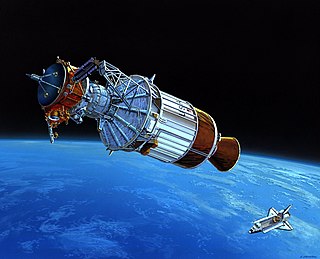
The Inertial Upper Stage (IUS), originally designated the Interim Upper Stage, was a two-stage, solid-fueled space launch system developed by Boeing for the United States Air Force beginning in 1976 for raising payloads from low Earth orbit to higher orbits or interplanetary trajectories following launch aboard a Titan 34D or Titan IV rocket as its upper stage, or from the payload bay of the Space Shuttle as a space tug.
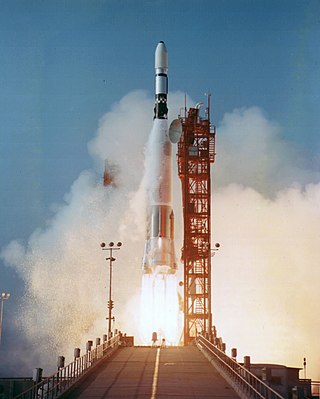
The Atlas-Agena was an American expendable launch system derived from the SM-65 Atlas missile. It was a member of the Atlas family of rockets, and was launched 109 times between 1960 and 1978. It was used to launch the first five Mariner uncrewed probes to the planets Venus and Mars, and the Ranger and Lunar Orbiter uncrewed probes to the Moon. The upper stage was also used as an uncrewed orbital target vehicle for the Gemini crewed spacecraft to practice rendezvous and docking. However, the launch vehicle family was originally developed for the Air Force and most of its launches were classified DoD payloads.

The Thorad-Agena was an American expendable launch system, derived from the Thor and Delta rockets. The first stage of the rocket was a stretched Thor variant named "Long Tank Thrust Augmented Thor". The Long Tank Thor first stage was later adopted by NASA's Delta program for its "Thrust Augmented Improved Delta", which first flew in 1968. The second stage was the Agena-D, which had already been used in conjunction with the standard configuration Thor, as the Thor-Agena. Three Castor rockets would be used as boosters. Most launches carried Corona (KeyHole) reconnaissance satellites, particularly spacecraft of the KH-4 series, however some scientific and technology development satellites were also flown, mostly towards the end of the program.

In rocketry, range safety or flight safety is ensured by monitoring the flight paths of missiles and launch vehicles. Various measures are implemented to protect nearby people, buildings and infrastructure from the dangers of a rocket launch. Ranges issue out closely guarded exclusion zones for air and sea traffic prior to launch, and close off certain areas to the public.
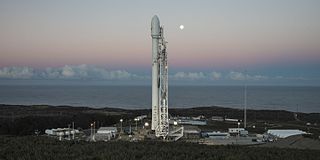
Space Launch Complex 4 (SLC-4) is a launch and landing site at Vandenberg Space Force Base, California, U.S. It has two pads, both of which are used by SpaceX for Falcon 9, one for launch operations, and other as Landing Zone 4 (LZ-4) for SpaceX landings.
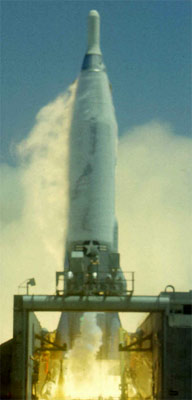
The SM-65E Atlas, or Atlas-E, was an operational variant of the Atlas missile. It first flew on October 11, 1960, and was deployed as an operational ICBM from September 1961 until April 1966. Following retirement as an ICBM, the Atlas-E, along with the Atlas-F, was refurbished for orbital launches as the Atlas E/F. The last Atlas E/F launch was conducted on March 24, 1995, using a rocket which had originally been built as an Atlas E.
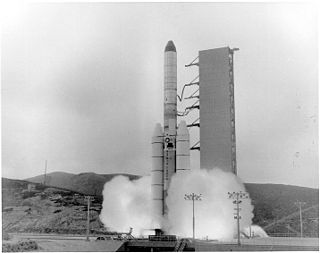
The Titan IIID or Titan 3D was an American expendable launch system, part of the Titan rocket family. Titan IIID was flown 22 times with KH-9 and KH-11 satellites between 1971 and 1982, all successful launches. Essentially a Titan IIIC with the Transstage removed, it was designed for heavy LEO payloads.

The Delta 3000 series was an American expendable launch system which was used to conduct 38 orbital launches between 1975 and 1989. It was a member of the Delta family of rockets. Several variants existed, which were differentiated by a four digit numerical code.

The Titan 23G, Titan II(23)G, Titan 2(23)G or Titan II SLV was an American expendable launch system derived from the LGM-25C Titan II intercontinental ballistic missile. Retired Titan II missiles were converted by Martin Marietta, into which the Glenn L. Martin Company, which built the original Titan II, had merged. It was used to carry payloads for the United States Air Force (USAF), NASA and National Oceanic and Atmospheric Administration (NOAA). Thirteen were launched from Space Launch Complex 4W (SLC-4W) at the Vandenberg Air Force Base between 1988 and 2003.
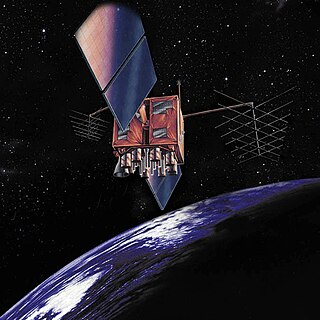
GPS IIR-1 or GPS SVN-42 was the first Block IIR GPS satellite to be launched. It was to have been operated as part of the United States Air Force Global Positioning System. It was launched on 17 January 1997, and was destroyed 13 seconds into its flight due to a malfunction of the Delta II launch vehicle that was carrying it. It was estimated to have cost US$40 million, with its launch vehicle costing US$55 million. The satellite that was used for the GPS IIR-1 mission was the second production IIR satellite, SVN-42.






















